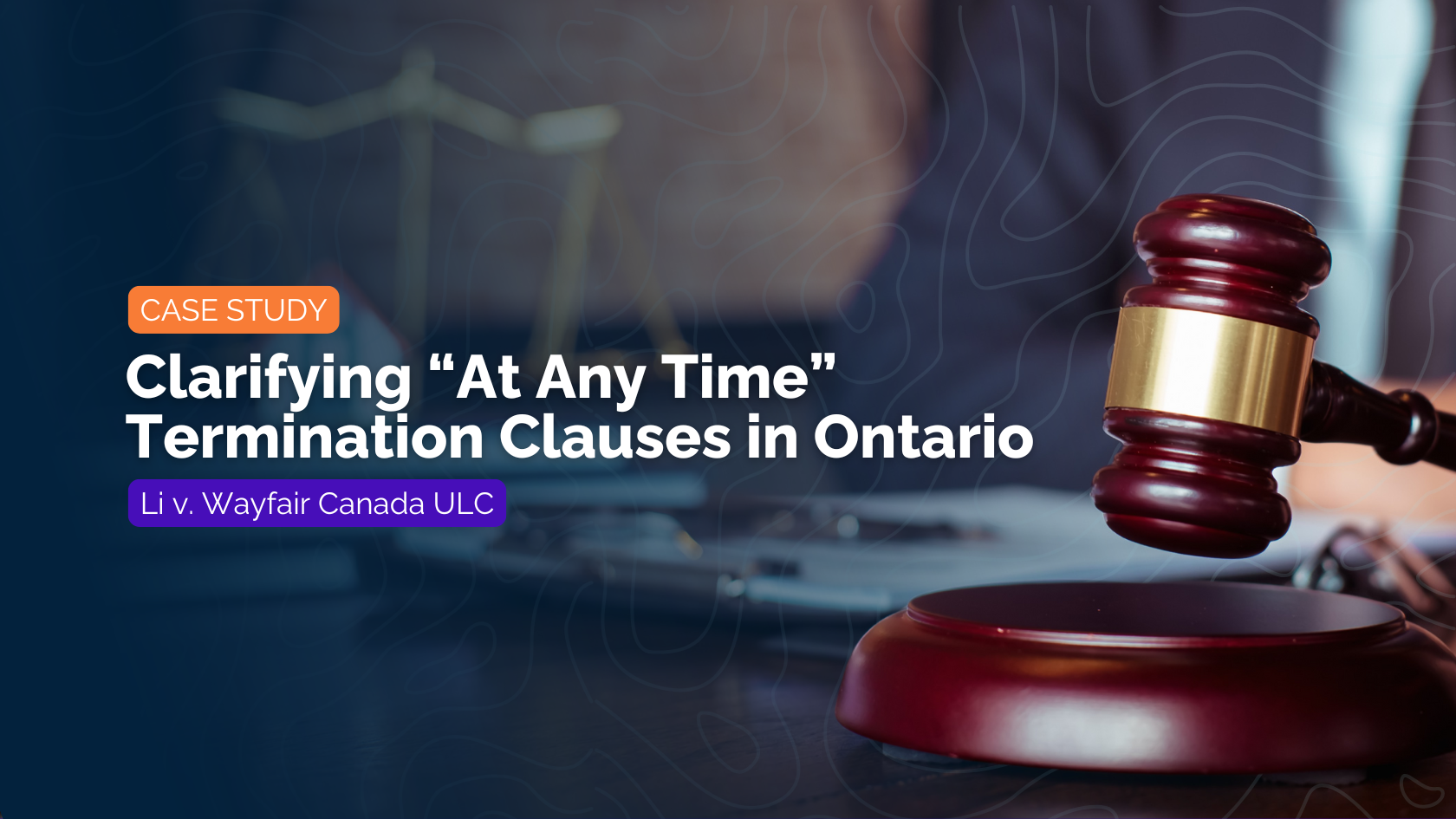Why This Case Matters
Ontario courts have long grappled with the enforceability of employment termination clauses stating that an employee can be dismissed “at any time.” Li v. Wayfair Canada ULC, 2025 ONSC 2959, marks a pivotal moment in this discussion. Unlike some recent decisions that struck down such clauses as unenforceable, this ruling upholds them—provided they comply with ESA minimum standards. This decision signals a shift in how Ontario courts interpret termination clauses, giving employers more clarity and flexibility.
Case Background
- Plaintiff: Song Li, Senior Product Manager
- Defendant: Wayfair Canada ULC
- Employment Duration: Jan 23, 2023 – Oct 17, 2023 (~9 months)
- Compensation Package: Annual salary of $221,564, benefits, RRSP contributions, and potential RSUs worth USD $73,017
Li challenged his termination under his employment agreement, which allowed termination “at any time,” seeking common law notice beyond the ESA minimums. Wayfair had provided only one week of pay and benefits, which was the ESA minimum.
Key Legal Principles Before Li
Since 2020, several key principles emerged regarding termination provisions:
- “Without cause” clauses granting “sole discretion” to terminate at any time may be unenforceable.
- An unenforceable “for cause” provision invalidates all termination provisions, including “without cause” clauses.
- Simply stating that ESA compliance will prevail does not automatically save a provision that contravenes statutory requirements.
These principles were prominently illustrated in:
- Dufault v. Township of Ignace, 2024 ONCA 915 – Both “for cause” and “without cause” clauses were found unenforceable because they did not comply with ESA minimums.
- Baker v. Van Dolder’s Home Team Inc., 2025 ONSC 952 – Highlighted the nuances in drafting termination provisions for short-term employment contracts.
These rulings marked a shift from prior case law that upheld similar “at any time” language.
Legal Context
This case builds on and contrasts with several key precedents:
- Dufault v. Township of Ignace, 2024 ONCA 915
- Struck down termination clauses stating “at any time” because they failed to comply fully with ESA minimums.
- Court emphasized employee protections due to unequal bargaining power.
- Waksdale v. Swegon North America Inc., 2020 ONCA 391
- Reinforced that employment contracts must be read in the context of ESA protections, and termination clauses that circumvent statutory rights may be unenforceable.
- Baker v. Van Dolder’s Home Team Inc., 2025 ONSC 952
- Addressed enforceability of termination clauses in short-term contracts but found distinctions based on contract language and compliance with ESA.
Termination Clauses in Li’s Employment Agreement
Without Cause:
“After your probationary period concludes, in the absence of Cause, the Company may terminate your employment at any time and for any reason by providing you with only the minimum statutory amount of written notice required by the ESA or by paying you the minimal amount of statutory termination pay in lieu of notice required by the ESA, or a combination of both, as well as paying statutory severance pay required by the ESA, providing benefits continuance for the requisite minimum statutory period under the ESA and all other outstanding entitlements, if any, owing under the ESA.”
For Cause:
“The Company may terminate your employment at any time for Cause without notice, pay in lieu of notice, severance, benefits continuance or other compensation or damages of any kind, unless expressly required by the ESA in which case only the minimum statutory entitlements will be provided.
For all purposes in this letter, ‘Cause’ means any willful misconduct, disobedience, or willful neglect of duty that is not trivial and has not been condoned by the company that constitutes ‘cause’ under the ESA.”
Court Analysis
Justice G. Dow focused on whether the termination clause complied with ESA standards. Key findings:
- For Cause Clause:
- Found enforceable. It clearly defined “cause” in line with ESA standards, limiting common law claims.
- Without Cause Clause:
- Critical finding: “At any time” language did not automatically render the clause unenforceable.
- The Court emphasized the clause’s explicit ESA compliance, including statutory notice, severance, and benefits.
- Distinguished from Dufault and Baker, where clauses failed to cover all types of wages or benefits.
- Common Law Notice:
- Had the provisions been unenforceable, the Court would have applied a four-month notice period.
Outcome: Li’s claims beyond ESA minimums were dismissed; the termination clauses were upheld as enforceable.
Employer Takeaways
- Clarity is Key:
Clearly define “cause” and “without cause” in employment agreements, referencing ESA obligations to ensure enforceability. - Comply with ESA Minimums:
Termination clauses that align with statutory minimums are more likely to be upheld—even if they state the employer may terminate “at any time.” - Read the Contract as a Whole:
Courts examine the agreement in its entirety; inconsistencies or missing references to statutory rights can void a clause. - Regularly Update Contracts:
Employment agreements should reflect current ESA standards and recent case law to reduce litigation risk.
Conclusion
Li v. Wayfair provides clarity in a previously uncertain area of employment law. It demonstrates that “at any time” clauses, when carefully drafted and aligned with ESA standards, can be enforceable, offering employers valuable guidance for drafting robust termination provisions. This decision signals a nuanced approach by Ontario courts: protecting employee rights while recognizing the legitimacy of clear, statutory-compliant contractual arrangements.
HRC Tip: Do you have any questions about this legal outcome and what it could mean for you? Don’t hesitate to contact us and our team of advisors is ready to help answer your questions!
Citation: https://www.hrcovered.com/wp-content/uploads/2025/09/Li-v.-Wayfair-Canada-ULC.-2025-ONSC-2959.pdf

